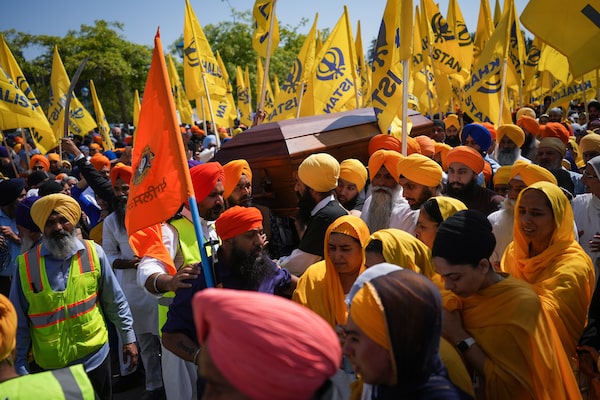
Mourners carry the casket of Sikh community leader and temple president Hardeep Singh Nijjar during funeral services for him in Surrey, B.C., on June 25.DARRYL DYCK/The Canadian Press
In the days after two masked men gunned down Hardeep Singh Nijjar outside the Sikh temple in Surrey, B.C., where he presided, homicide investigators said the shooting was targeted but declined to comment on speculation that the Indian government may have been involved. Instead, police have said little over the past three months about the killing or what may have prompted it, releasing only descriptions of suspects and pleading for witnesses and tips.
On Monday, three months to the day after Mr. Nijjar’s death, Prime Minister Justin Trudeau alleged that “agents” of the Indian state were behind the killing as he appeared to confirm what many of Mr. Nijjar’s supporters had long suspected.
The Prime Minister did not say who the government believes killed Mr. Nijjar. No one has been charged and the Vancouver region’s RCMP-led homicide squad, which has not spoken publicly about the case in more than a month, did not respond to requests for comment after the allegations about Indian involvement.
Mr. Nijjar, president of the Guru Nanak Gurdwara and an outspoken advocate of Sikh separatism, was gunned down on the evening of June 18 outside the temple in Surrey. The RCMP said at the time that he was attacked by two masked gunmen with heavy builds who fled on foot and escaped via a waiting car.
Investigators described the killing as “targeted” and said there was no wider threat to the Sikh community.
As Mr. Nijjar was leaving the temple, pulling out of its parking lot in his grey Dodge Ram pickup truck, two gunmen ran up to the driver-side window and fired several times before fleeing. Later footage viewed by The Globe and Mail showed Mr. Nijjar, wearing a blue striped dress shirt, slumped in his vehicle, with his window blown out. On the ground near the truck were 10 to 15 spent shells.
‘I can say goodbye once justice is done’: Family, friends react to revelation on Sikh leader’s death
Clark: Canada once more forced to reckon with era of foreign intimidation
In August, homicide investigators announced they were looking for a third suspect believed to be the getaway driver, who is said to have waited in a silver 2008 Toyota Camry for the gunmen.
Mr. Nijjar had already told associates that he had received cryptic warnings from Canadian Security Intelligence Service intelligence officers that someone was coming to harm him. Hours before the shooting, Mr. Nijjar gave a speech to the gurdwara in which he told congregants that advocating for Sikh rights in the Indian state of Punjab was treacherous work.
“The coming time is very dangerous,” Mr. Nijjar had said in Punjabi during a speech he gave to the Guru Nanak Gurdwara.
In the years before his death, Mr. Nijjar made no secret of the fact that India’s National Investigative Agency publicly accused him of being a terrorist. Last July, the NIA offered a reward for information leading to his arrest.
The killing happened as a group called Sikhs for Justice has been staging a symbolic referendum to advocate for a separate Sikh territory known as Khalistan.
Mr. Nijjar arrived in Canada in 1997 and filed a refugee claim that was initially denied. In Surrey, he was known as a plumber and a prayer leader, a husband and father of two adult sons. According to a lawsuit, he was a trusted keeper in Canada of holy-book-printing equipment controlled by the Akal Takhat, the Sikh religion’s highest authority.
Months prior to the shooting, the temple was sued by another Sikh faction over control of the book-printing machinery temporarily entrusted to his control.
Mr. Nijjar’s death is the second in two years of a prominent member of the Sikh community in Canada. Last July, Ripudaman Singh Malik, one of two men acquitted in the 1985 Air India bombing, was also shot and killed in Surrey.
In the aftermath, Mr. Nijjar and his lawyer publicly denied reports in the Hindustan Times suggesting that Mr. Nijjar might have played a role in Mr. Malik’s death.
Editor’s note: This article has been update to clarify the details of Mr. Nijjar's arrival in Canada.